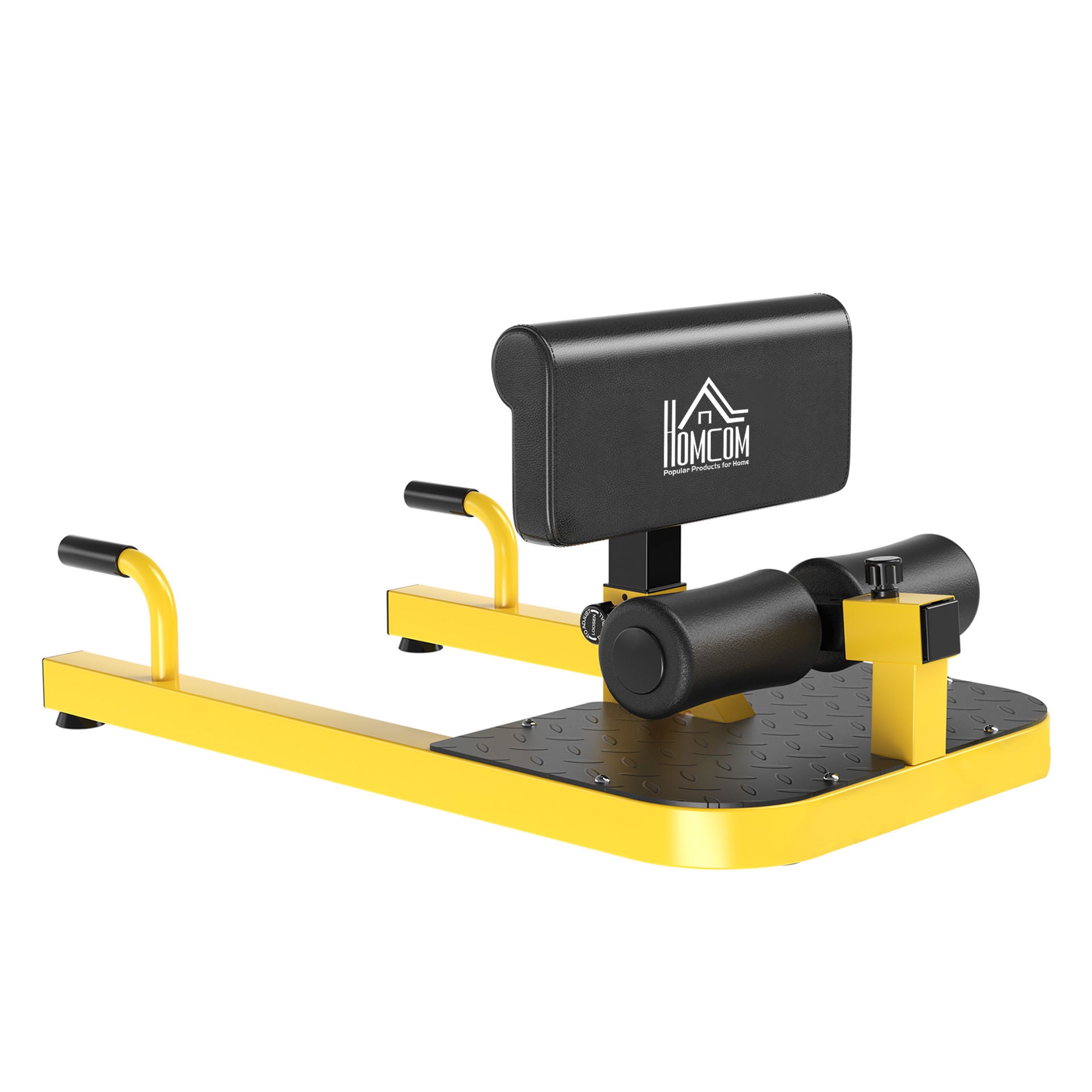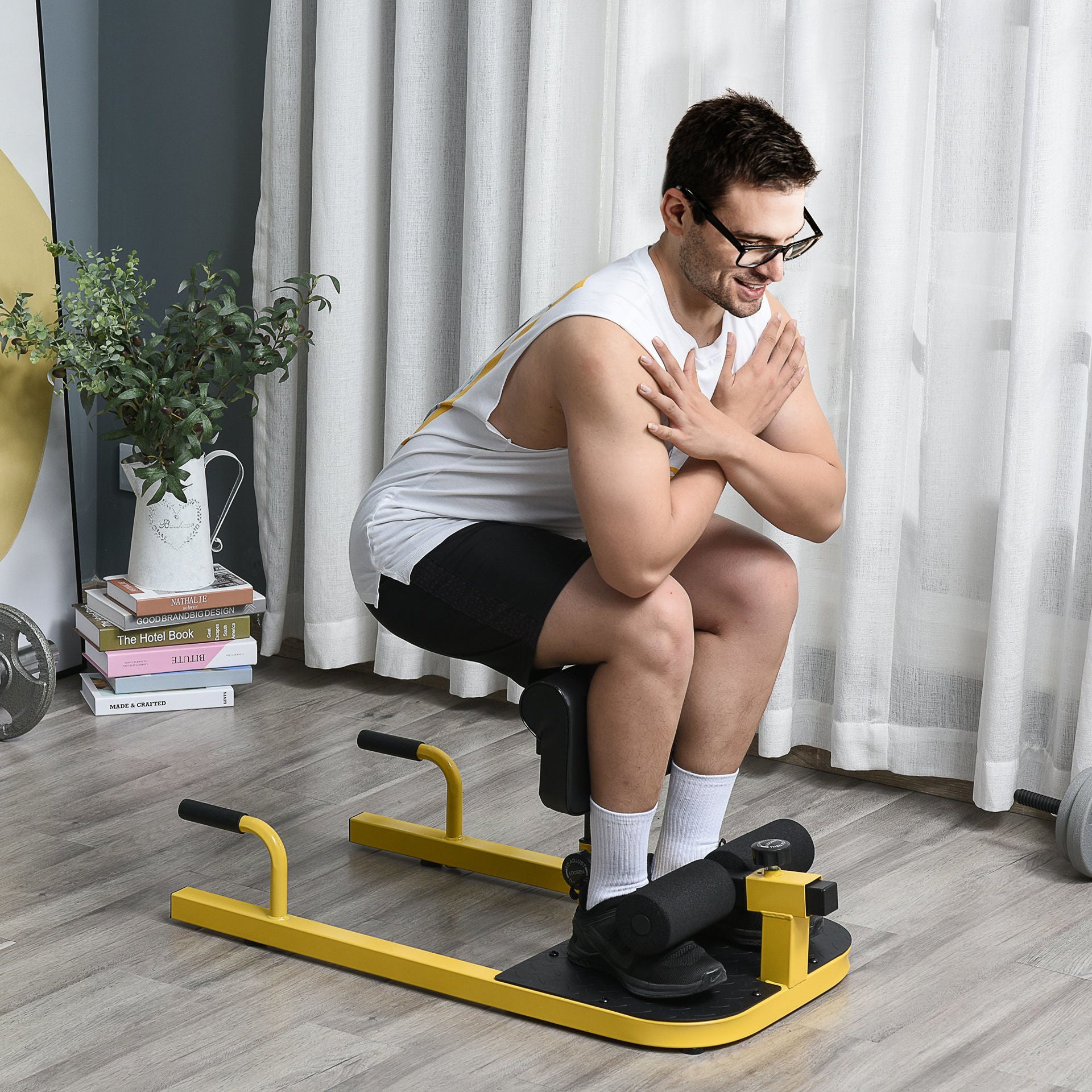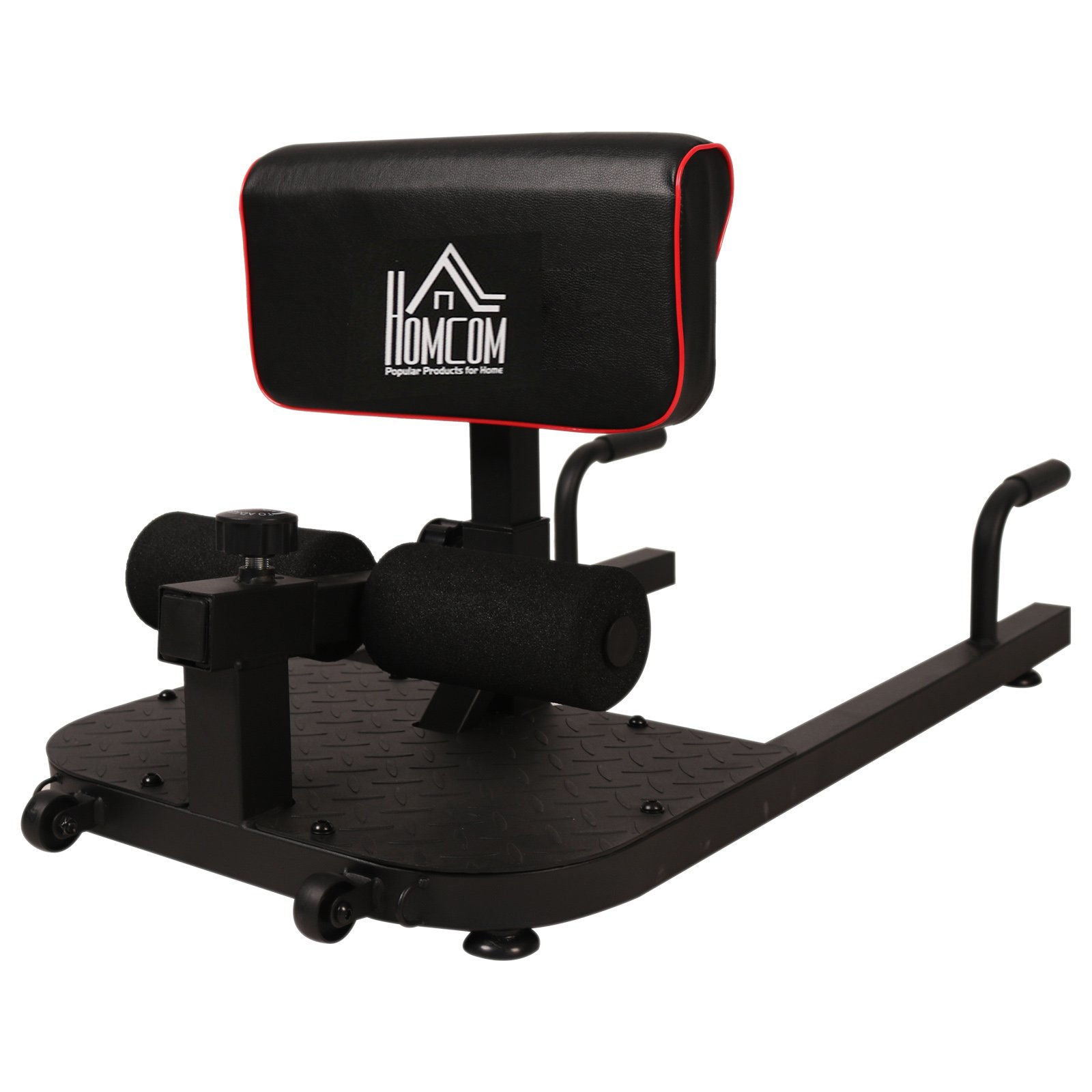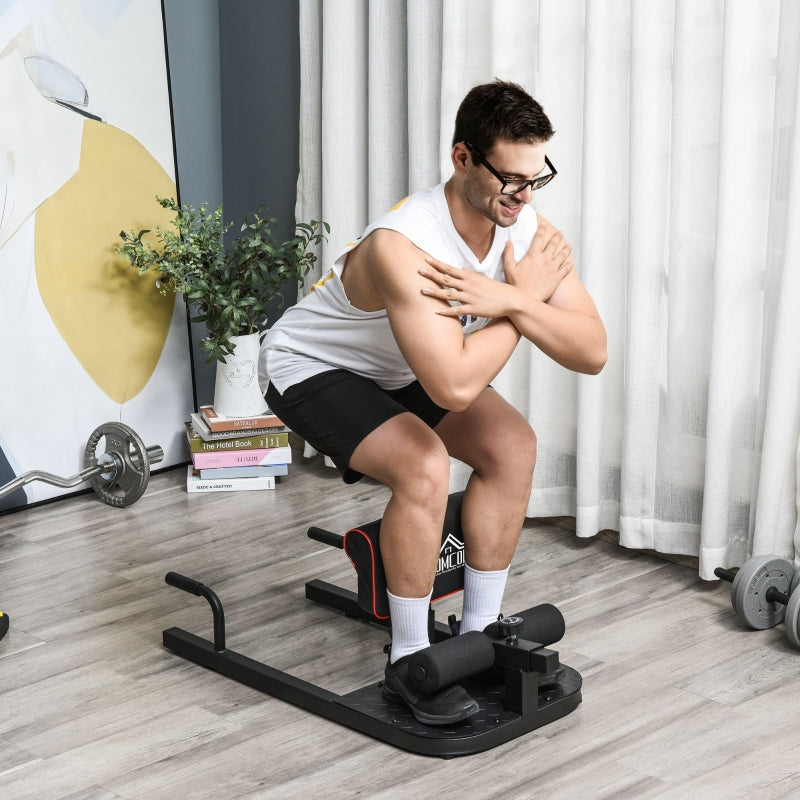Nancy's Ardtrea Squat knee flexor trainer - leg trainer, abdominal and gluteal muscle trainer - 3 in 1 trainer adjustable up to 120 kg
The Ardtrea 3 in 1 trainer from Nancy is produced with high-quality materials and is designed as a g...Leg Trainer - Squat




Nancy's Aulnay Leg Trainer - Squat Trainer - Knee Bend Trainer - Abdominal/Buttocks Trainer - Multifunctional - Adjustable - Black / Yellow
Gratis verzonden
Fast delivery, 2 to 5 working days
Collection: Leg Trainer - Squat Effective leg muscle training: why and how
Muscular arms look impressive, but for effective muscle training, training the large muscle groups in the legs and buttocks is essential. By focusing on this large muscle mass, you will achieve maximum gains in fat burning and insulin sensitivity, both beneficial properties of muscle tissue. Squatting is one of the simplest and most effective exercises to achieve this goal. If the technique is performed correctly and the squat exercises are varied, significant effects can be achieved with even a few minutes of training per day. Start with about 10 repetitions and build up to 3 sets of 20 repetitions per day for strong and well-developed legs and squat buttocks.
Squat Posture and Technique
When performing a squat, it is important to adjust the depth to your own ability. It is okay to go deep as long as you can come back up without difficulty. If your body has to bend forward to come up, this means you have gone too deep and the exercise will be less effective. If you have knee pain, it is best not to go too deep and to stop when your thighs and shins form a 90-degree angle. As you get stronger and your knees are healthy, deeper squats can also help activate more muscles. The right squat form makes all the difference; by properly adjusting your squat rack or using a squat machine, you can reduce your risk of injury and improve your technique.
15 Squat Exercises for Home and Gym
- Classic squat: Stand upright with your feet slightly apart, shoulder width apart, and your toes pointing straight ahead. Extend your arms forward, push your buttocks and hips back, and bend your knees as if you were going to sit down. Make sure your knees and upper body do not extend beyond your feet. Hold the position for a moment and come back up. This is the basis of every squat exercise.
- Sumo squat: Stand with your feet wider apart and your toes slightly turned out. Press your fists together in front of your sternum and bend your knees while keeping your back upright. By placing your legs further out to the side, this variation places more emphasis on your glutes and inner thighs.
- Spring squat: Do the classic squat, but stay at the bottom, come up a little bit and then go back down. Spring up and down 10 times without coming up completely. By varying the tempo you can make the exercise harder or easier.
- Squat and jump: For advanced users, the classic or sumo squat can be combined with a jump. When coming up, make a jump and immediately return to the squat position. For extra intensity, stretch your arms diagonally backwards while jumping or hold them in front of your chest.
- Squat with weight: Hold a weight, such as a dumbbell, barbell (on your shoulders or in front of your chest) or squat dumbbell in front of your chest and perform the classic squat. Make sure your upper body remains straight as you bend your knees. This squat with dumbbell exercise helps you build muscle in your entire lower body.
- Squat one leg: This challenging variation requires balance and strength. Stand on one leg, bring the other leg slightly forward and perform a squat on the supporting leg. This not only strengthens your legs and squat buttocks, but also promotes stability and coordination.
- Squat lunge combination: Combine the squat with a lunge to add extra variety and intensity to your workout. First go into a squat and then immediately step into a lunge with one leg back. This squat lunge ensures maximum muscle activation in both the glutes and the thighs.
- Squat with stairs: Find a stair and place one foot on the bottom step. Perform a one leg squat and then switch legs. This is a great exercise to improve stability and strength in your legs.
- Squat 30 day challenge: Challenge yourself to add a squat exercise every day for 30 days. Start with a few reps and build up the number daily. This squat 30 day challenge will make you progressively stronger and more muscular, especially in your lower body.
- Squat with dumbbell twist: Grab a squat dumbbell and perform a squat. When coming up, twist your upper body to one side, which ensures extra activation of the abdominal muscles. A perfect exercise for a strong core and tight squat buttocks.
- Bulgarian squat: Use a squat rack or platform and place one foot on it. Perform a lunge-like movement and feel the power in your legs increase. This variation is widely used in strength training and improves balance and muscle strength.
- Explosive squat jump: Add some extra intensity to your workout by doing an explosive squat jump. This will not only build muscle strength, but also increase your explosiveness, which can be useful for athletic performance.
- Wall squat with weight: Stand with your back against a wall and perform a squat while holding a squat dumbbell. Hold this position to add a static challenge and work your muscles extra.
- Kettlebell squat: Grab a kettlebell and perform the squat as you would a dumbbell squat. The difference in balance and weight provides variation and offers your muscles new stimuli.
- Squat rack with barbell: Use a squat rack to get into the right position and perform heavy squat exercises. By using a squat rack you can safely train with heavy weights.
The benefits of a leg trainer
With a leg trainer you train the most important muscle groups in the legs, including the triceps surae (calf muscles), quadriceps femoris (thighs), hamstring femoris and gluteus maximus (buttock muscles). Squat machines and leg trainers are indispensable for this. The expression 'never skip leg day' emphasizes the importance of a strong base in the body, and a leg trainer supports you in strengthening these muscle groups effectively and safely.
Types of Leg Exercises and Their Effects
Leg trainers come in different variations. Some allow you to perform compound exercises that train multiple muscle groups at once. Others are designed for isolation exercises, where the focus is on one muscle group. Isolation exercises are ideal for specific muscle development, such as during rehabilitation or mass training.
- Leg Press: A popular compound exercise that works your quadriceps, hamstrings, glutes and calves. This exercise is great for strengthening the lower body.
- Leg Extension and Leg Curl: Leg Extension targets the quadriceps, while the Leg Curl activates the hamstrings. Both exercises are isolating and provide effective muscle development in the upper leg.
- Squat with squat rack: By performing a squat with a squat rack, where the rack can support the barbell at different heights, you can safely perform heavy squat exercises. Squat racks are versatile and suitable for other exercises such as squat lunge or squat with dumbbell.
Why train leg muscles?
The muscles in your legs, including your glutes, are the largest muscle groups in your body. Regularly training these muscles during strength training increases the production of growth hormone, which is distributed throughout your body and contributes to overall muscle growth. Training your leg muscles not only contributes to a balanced, symmetrical body, but also helps prevent injuries.
Why a squat rack is essential
A squat rack provides a safe environment for heavy squats. The metal frame has adjustable crossbars that help position the barbell at a comfortable height. Training with a squat rack minimizes the risk of injury, as the adjustable safety bars act as a safety net in case of muscle failure. In addition, a squat rack is versatile and can be used for other exercises as well.
Effective leg muscle training: why and how
Muscular arms look impressive, but for effective muscle training, training the large muscle groups in the legs and buttocks is essential. By focusing on this large muscle mass, you will achieve maximum gains in fat burning and insulin sensitivity, both beneficial properties of muscle tissue. Squatting is one of the simplest and most effective exercises to achieve this goal. If the technique is performed correctly and the squat exercises are varied, significant effects can be achieved with even a few minutes of training per day. Start with about 10 repetitions and build up to 3 sets of 20 repetitions per day for strong and well-developed legs and squat buttocks.
Squat Posture and Technique
When performing a squat, it is important to adjust the depth to your own ability. It is okay to go deep as long as you can come back up without difficulty. If your body has to bend forward to come up, this means you have gone too deep and the exercise will be less effective. If you have knee pain, it is best not to go too deep and to stop when your thighs and shins form a 90-degree angle. As you get stronger and your knees are healthy, deeper squats can also help activate more muscles. The right squat form makes all the difference; by properly adjusting your squat rack or using a squat machine, you can reduce your risk of injury and improve your technique.
15 Squat Exercises for Home and Gym
- Classic squat: Stand upright with your feet slightly apart, shoulder width apart, and your toes pointing straight ahead. Extend your arms forward, push your buttocks and hips back, and bend your knees as if you were going to sit down. Make sure your knees and upper body do not extend beyond your feet. Hold the position for a moment and come back up. This is the basis of every squat exercise.
- Sumo squat: Stand with your feet wider apart and your toes slightly turned out. Press your fists together in front of your sternum and bend your knees while keeping your back upright. By placing your legs further out to the side, this variation places more emphasis on your glutes and inner thighs.
- Spring squat: Do the classic squat, but stay at the bottom, come up a little bit and then go back down. Spring up and down 10 times without coming up completely. By varying the tempo you can make the exercise harder or easier.
- Squat and jump: For advanced users, the classic or sumo squat can be combined with a jump. When coming up, make a jump and immediately return to the squat position. For extra intensity, stretch your arms diagonally backwards while jumping or hold them in front of your chest.
- Squat with weight: Hold a weight, such as a dumbbell, barbell (on your shoulders or in front of your chest) or squat dumbbell in front of your chest and perform the classic squat. Make sure your upper body remains straight as you bend your knees. This squat with dumbbell exercise helps you build muscle in your entire lower body.
- Squat one leg: This challenging variation requires balance and strength. Stand on one leg, bring the other leg slightly forward and perform a squat on the supporting leg. This not only strengthens your legs and squat buttocks, but also promotes stability and coordination.
- Squat lunge combination: Combine the squat with a lunge to add extra variety and intensity to your workout. First go into a squat and then immediately step into a lunge with one leg back. This squat lunge ensures maximum muscle activation in both the glutes and the thighs.
- Squat with stairs: Find a stair and place one foot on the bottom step. Perform a one leg squat and then switch legs. This is a great exercise to improve stability and strength in your legs.
- Squat 30 day challenge: Challenge yourself to add a squat exercise every day for 30 days. Start with a few reps and build up the number daily. This squat 30 day challenge will make you progressively stronger and more muscular, especially in your lower body.
- Squat with dumbbell twist: Grab a squat dumbbell and perform a squat. When coming up, twist your upper body to one side, which ensures extra activation of the abdominal muscles. A perfect exercise for a strong core and tight squat buttocks.
- Bulgarian squat: Use a squat rack or platform and place one foot on it. Perform a lunge-like movement and feel the power in your legs increase. This variation is widely used in strength training and improves balance and muscle strength.
- Explosive squat jump: Add some extra intensity to your workout by doing an explosive squat jump. This will not only build muscle strength, but also increase your explosiveness, which can be useful for athletic performance.
- Wall squat with weight: Stand with your back against a wall and perform a squat while holding a squat dumbbell. Hold this position to add a static challenge and work your muscles extra.
- Kettlebell squat: Grab a kettlebell and perform the squat as you would a dumbbell squat. The difference in balance and weight provides variation and offers your muscles new stimuli.
- Squat rack with barbell: Use a squat rack to get into the right position and perform heavy squat exercises. By using a squat rack you can safely train with heavy weights.
The benefits of a leg trainer
With a leg trainer you train the most important muscle groups in the legs, including the triceps surae (calf muscles), quadriceps femoris (thighs), hamstring femoris and gluteus maximus (buttock muscles). Squat machines and leg trainers are indispensable for this. The expression 'never skip leg day' emphasizes the importance of a strong base in the body, and a leg trainer supports you in strengthening these muscle groups effectively and safely.
Types of Leg Exercises and Their Effects
Leg trainers come in different variations. Some allow you to perform compound exercises that train multiple muscle groups at once. Others are designed for isolation exercises, where the focus is on one muscle group. Isolation exercises are ideal for specific muscle development, such as during rehabilitation or mass training.
- Leg Press: A popular compound exercise that works your quadriceps, hamstrings, glutes and calves. This exercise is great for strengthening the lower body.
- Leg Extension and Leg Curl: Leg Extension targets the quadriceps, while the Leg Curl activates the hamstrings. Both exercises are isolating and provide effective muscle development in the upper leg.
- Squat with squat rack: By performing a squat with a squat rack, where the rack can support the barbell at different heights, you can safely perform heavy squat exercises. Squat racks are versatile and suitable for other exercises such as squat lunge or squat with dumbbell.
Why train leg muscles?
The muscles in your legs, including your glutes, are the largest muscle groups in your body. Regularly training these muscles during strength training increases the production of growth hormone, which is distributed throughout your body and contributes to overall muscle growth. Training your leg muscles not only contributes to a balanced, symmetrical body, but also helps prevent injuries.
Why a squat rack is essential
A squat rack provides a safe environment for heavy squats. The metal frame has adjustable crossbars that help position the barbell at a comfortable height. Training with a squat rack minimizes the risk of injury, as the adjustable safety bars act as a safety net in case of muscle failure. In addition, a squat rack is versatile and can be used for other exercises as well.






